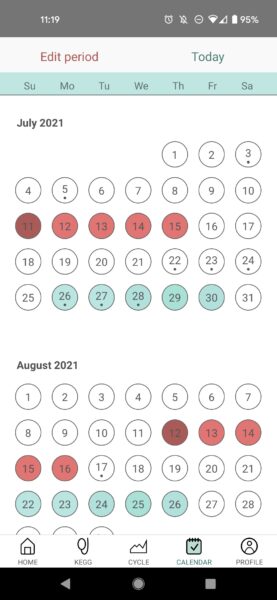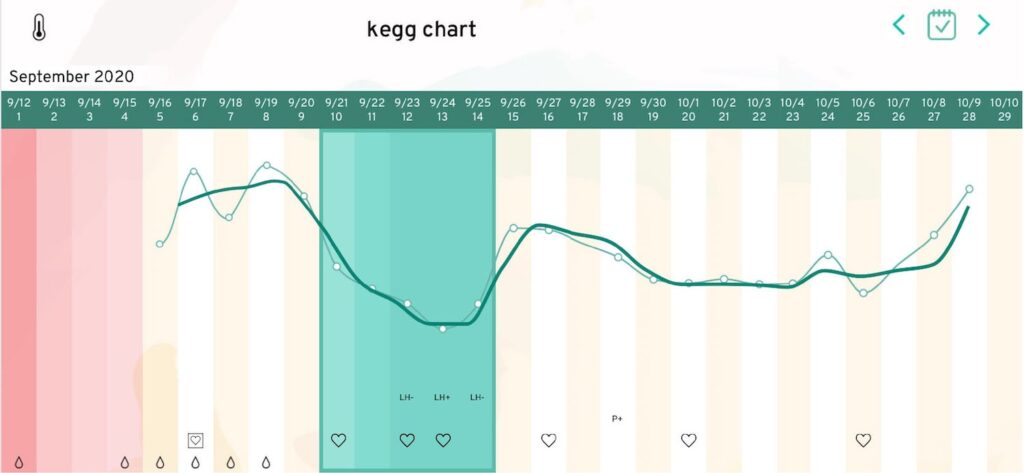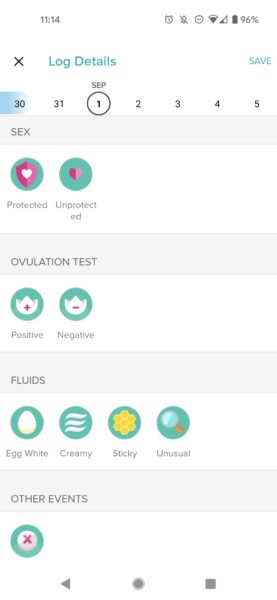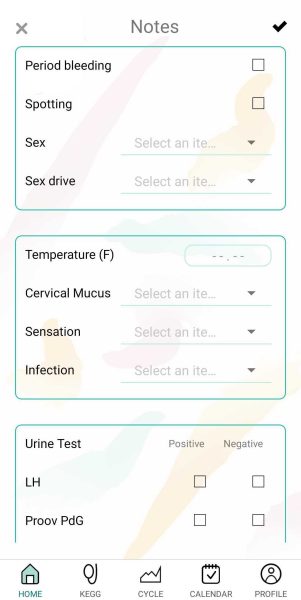At a Glance:
- Fitbit offers a “Menstruation Health Feature” which uses the “Calendar-Method” to predict the fertile window and cycle length
- Fitbit will assume your luteal phase length, or duration of time between ovulation and the start of the new cycle, is 14 days, but this varies among women between 11-17 days (and sometimes even fewer days), which causes this prediction to be grossly inaccurate for many.
- The Fitbit user can input only very limited data into the journal
- kegg tracks the changes in your cervical fluid so the user can see precisely when they are in their unique fertile window
- kegg’s algorithm accounts for the user’s unique cycle, and confirms your fertile window by scanning your kegg data, rather than assuming all users have a luteal phase length that is the same
- The kegg app allows users to input many sources of information into the journal so that the user can conveniently track all of their fertility related data in one convenient place
- The kegg user will see their daily readings plotted on the kegg chart. This means the user can see their fertile window unfold in real-time, as well as see when the algorithm predicts when it will happen in advance
A couple of months ago, my husband gifted me a Fitbit Luxe Special Edition that comes with a gold stainless steel Parker Link Bracelet and it can easily be shortened to fit even small wrists. Eureka, I thought! I love it.
While getting to know the device better, I noticed a tab saying ‘11 days until your next period’. I probably answered some questions during the setup of my account and totally forgot about the cycle tracking option from Fitbit. I became curious about it and started to investigate further. Fitbit doesn’t promote this feature a lot on their website, so I had to do my own research.
Fitbit – Calendar view
It’s a little bit hard to find. Considering this is not a major Fitbit Feature, it probably has not been prioritized in the Product Menu. It’s not retroactive and it predicts only future cycles.

kegg – Calendar view
The calendar is one of the 5 main tabs you can find on the app main Menu. It also shows past cycles, before your kegg purchase, and the data on the current month/cycle re-adjusts at the end of the cycle to confirm what it previously predicted.

I like the ‘Trends’ tab in the Fitbit app, but I didn’t want to get too excited too fast.
The Trends tab in Fitbit is a simple recap of your ‘cycle status’ so far. Nice to look at but not too insightful especially if you need actionable real-time data.


Indeed, while the Fitbit Trends tab doesn’t really give me further information, by simply observing the kegg trendline I can spot if for example in one month my fertile window is delayed compared to the prediction (and we all know what stress and traveling can do to our cycles!)
One last aesthetic comment about the difference between kegg and Fitbit: optional journal notes. If you are simply here to track your cycles / menstrual health, Fitbit doesn’t really offer you much more than other tracking apps like Flo Health. (If you are curious, here is a comparison between fertility trackers available on the market).
If you are trying to conceive, I believe the Journal notes you can take on Fitbit are very limited. Let’s take a closer look at them.
On Fitbit, you can only ‘Log details’ about sex (protected and unprotected), Positive or Negative Ovulation test, Fluids, and other events like the Morning After Pill.


What makes kegg different from Fitbit’s Menstrual Health feature?
Fitbit
In the Fitbit app, the predictions for your period, fertile window, and ovulation day are estimated using an algorithm that includes the period and cycle length information you provide. If you don’t provide some of the information about your cycle, Fitbit uses a 28-day cycle and a 5-day period as a starting point for estimations. (source: Fitbit website).
The Fitbit algorithm uses the so-called Calendar Method. The Calendar Method assumes ovulation occurs 14 days from the total average cycle length. There are several issues and inaccuracies with this approach:
- While the luteal phase (second half of the menstrual cycle) is on average 14 days long among women who menstruate and tends to be fairly consistent per person, the length varies between women.
- The second problem is that your cycle is not likely going to be exactly the same every month. My cycle averages 32 days in length, but I’ve experienced cycles anywhere from 29 days to 34 days in length, and my cycles are very regular. This means that the predicted fertile period on Fitbit is even more inaccurate. My peak fertility occurs around day 17 and since I stopped taking my birth control pill and I endured lots of stress, it tends to fluctuate between days 12 and 17. But Fitbit thinks I ovulate three days earlier than I actually have my fertility peak on kegg.
- Another inaccuracy comes from the focus on ovulation. We all know at this point that you cannot know your exact day of ovulation without a perfectly timed ultrasound and cannot confirm your ovulation without blood work, a urine test, or an extremely consistent BBT tracking. This can be misleading particularly to those trying to conceive.
Since Fitbit monitors every moment of your day, from walking to sleeping, your heart rate variability, and everything in between, I was expecting precise insights about my cycles and how my activity level, lack of sleep, and stress could impact my menstrual health, but it didn’t live up to my expectations.
kegg
Cervical fluid is the key sign to knowing your fertile window. Cervical mucus plays a critical role in fertility and conception. Sperm cannot survive in the female reproductive tract without cervical fluid to nourish and sustain them on the journey to the egg. kegg helps pinpoint when the conditions are ideal to nourish and sustain the sperm.
It can be challenging to track cervical fluid by manual observation and understand when cervical mucus is sperm-friendly. With kegg, the user can see real-time insights so there is no guesswork regarding when the fertile window occurs.
Unlike the calendar tracking method, kegg plots your daily readings on the kegg app. In addition to the green fertile window prediction provided by the kegg algorithm, the user can see when their fertile window occurs by looking at the overall trend of their readings. As the cervical fluid becomes more hospitable to sperm, the kegg user will see a downward trend in their kegg reading. After ovulation has occurred, there is then a rise in kegg readings. This fertile window appears as a “valley”. Instead of making subjective observations of the quantity and quality of the cervical mucus, kegg objectively plots the composite electrolyte reading. The user simply takes a 2-minute reading within the same 2-hour time frame daily. kegg does the rest!
kegg learns from past fertile window confirmations, kegg readings, and cycle lengths to place the fertile window prediction. The fertile window’s “anchor point” is on the predicted days of peak fertility: days 3,4 and 5 of the fertile window. Peak fertility is most often on day 4 or 5 of the confirmed fertile window of a completed cycle. kegg labels days 1 and 2 of the fertile window prediction as “possible” fertility and days 3-5 as “likely” fertility. Days outside of the green fertile window are predicted to be “low” fertility. If a new cycle is logged by the user, the algorithm will survey the full cycle and place a fertile window confirmation.
To conclude, when tracking your cycles with kegg and you want to optimally time your intercourse to maximize your chances of conception, you can confirm your fertile window is occurring by:
- Look at the predicted fertile window and the days labeled as POSSIBLE – LIKELY”
- Check your daily readings, to identify the downward trend that will form the “valley” during the fertile window.
I learned a lot by investigating Fitbit vs. kegg’s fertility predictions. The Fitbit’s cycle tracking component is very underwhelming. I will continue to use Fitbit for its intended use: tracking my steps, calories, and sleep core. But, my fertility is not a guessing game, so I will depend on kegg to track my cycles. In addition, cervical fluid is a window into my overall health so I will benefit from seeing this cycle after cycle.

